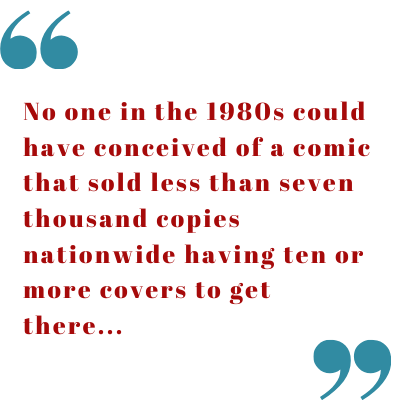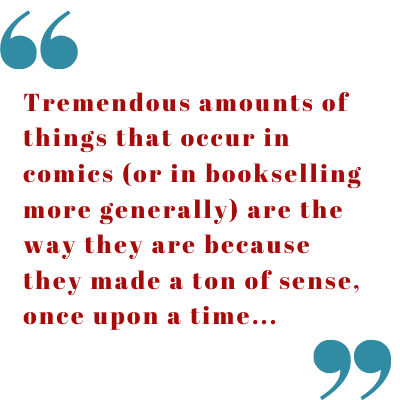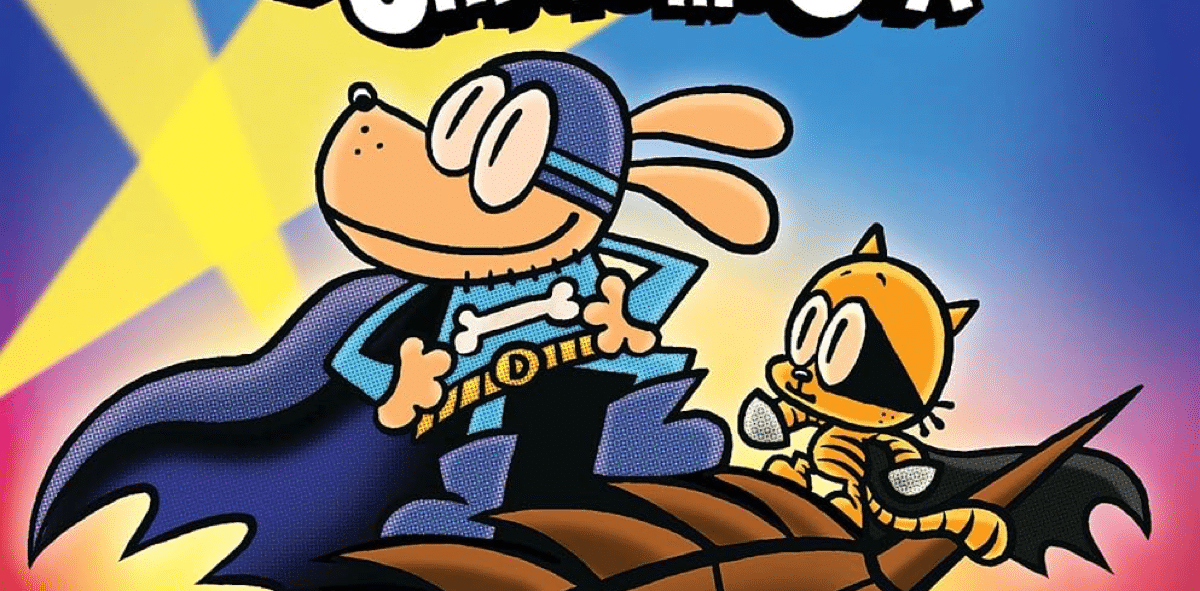
By Brian Hibbs
[Editor’s note:this column was written at the end of January, before a lot of recent events in comics, so read accordingly.]
One of the weird things about getting old in comics retail is, well, dealing with the Youngs. The store is coming up on thirty-one years of operations, and that means I am at something like thirty-four years of selling comics, and there are days that I feel like I spend most of my time explaining to people why things are the way that they are.
(That’s not at all a bad position to be in, but, internally, I’m often confused about how I moved from being “Young Firebrand” to “Font Of Wisdom”!)
We’ve had an unusual amount of staff turnover just now (San Francisco is a brutal and expensive city to live in these days), so we have like four new employees all being trained at roughly the same time (including being trained for higher positions), and I’ve found myself not really sure what I’ve told who and when any more as a result. There are so many little details and “oh pay attention to this” and “Well, this is different because…” – all of which that I’ve slowly internalized over my four decades in comics, but all tremendously hard to teach (or be taught!) in any kind of a data-dump.
One thing that I keep stressing is that Everything Is The Way It Is for (at least) Once Logical Reasons. Tremendous amounts of things that occur in comics (or in bookselling more generally) are the way they are because they made a ton of sense, once upon a time, and often the best thing one can do is to try to look back at history to find the roots.
Actually, I genuinely think this is even more true in bookselling than it is the comics – I generally think that the accretion of “this is how one sells books” dates back a century or [much] more, while the Direct Market hasn’t even hit its own half-century mark. As I have noted, Comix Experience has moved a ginormous chunk of our graphic novel purchasing outside of the Diamond ecosystem over the last year, into the more “mainstream” book publishing world – to Penguin Random, and Simon & Schuster, and Scholastic, and Macmillan, and Hachette, and Harper Collins and Ingram – partly to save money (the shipping charges that Diamond charges are damn brutal), but also to actually be able to stock a whole lot of material that Diamond is just slllllllllow to react to.
We’re at just over a year into this process, and while I am very happy with the changes we’ve made, I often bang my head against the accretions of processes, with the nomenclature traditions, and with the methods of thinking in the book world, all of which make a ton of sense (well, I presume) to the users over there, but as a “new person” coming in from the outside seems really dense and convoluted and poorly designed.
But, I can see through the eyes of my staff (most of which are only three-quarters as old as the store has existed or less! Wow, does that creep me out to type!), that they find a lot of DM processes arcane and strange and with odd burdens of history too.
Ugh, and there’s just so much to teach these days! Even small things like “if you want to look up ‘Buffy, The Vampire Slayer’ in the database, you also should try ‘BTVS’” – I know why that is (There’s a hard fifty-character limit, including spaces, in what a Diamond invoice can print and “BTVS” only uses four, instead of twenty-five) – but you try to keep remembering all of these rules and edge cases and reasons to have to teach them to people over and over again.
Part of the problem, at least in comics, is that the system was never designed… well, I could probably cut that off right there, because it’s really true that the system was never “designed” in the first place, but what I really need to type is that the system was never designed thinking that there could ever be as many SKUs as there are today! Periodicals title-count alone have increased at least four fold since I opened, and if you start getting into the various variant covers it probably pushed it closer to twice that – no one in the 1980s could have conceived of a comic that sold less than seven thousand copies nationwide having ten or more covers to get there, and now there are dozens of series like that. And when we start looking at Graphic Novels, well, I doubt if there were twenty titles that were perpetually-and-purposefully-in-print when I opened in 1989 (that’s why Alan Moore feels ripped off over Watchmen!), and now there are at least six thousand titles that I keep in stock, and something close to forty thousand I could be stocking, if only I had an infinite store room and budget.

So, my job as a retailer becomes to curate between the crazily numerous strains of awesomeness and the Physical limits of my rack space in the middle of trying to make a profit because I’m balancing stock-on-hand vs ability/speed-to-turn, right?
That’s a hard-ass job because of the sheer number of SKUs, and the sheer lack of actually modulated promotion from the marketing and promotion guys – cutting the wheat from the chaff is insanely hard because there is so much chaff.
And it’s hard, deeply truly, crazily hard, not just to curate all of that stuff, but to do so in a way that makes the slightest amount of sense to a young and ever-changing staff. “No, the reason you can’t find that in the database is because it’s called ‘LOEG’ and not ‘League of Extraordinary Gentlemen’” is pretty counter-intuitive, right?
Mechanically comics made a bunch of mistakes back in the 90s when SKU counts started to grow by not institutionalizing naming conventions. My buddy Michael Drivas (Big Brain Comics in Minneapolis, may that store rest in peace) used to go to conventions and shows with “Folks, please hire trained librarians to organize your databases” – no one ever listened to him, and it is kicking us in the teeth these days.
We just did a hard-inventory of the store last Monday (sixty-five man-hours!) – first one in like five years – and by far the thing that slowed us down the most was the lack of sensible naming conventions. And, here’s the deal folks: if the staff can’t find a book, if the staff can’t even necessarily find any easy way to search for a book, then the staff sure won’t be selling it to anyone.
I worry about these kinds of things (and eleventy billion other “why is it like this” questions), because the Youngs are our future. I’m fifty-three now, and while I surmise I’ve got at least another decade in me of running a comic book store, any staffer that I hire right now might have four decades in front of them if they don’t get chased off. There’s a lot that can chase them off, is the problem, because of the accretion of little problems is turning into big problems over all.
“Metadata”, the bits that allow us to organize and flow information, be it simple decisions like title-driven ideas about what we abbreviated and how and how we consistently apply those standards, to more complex ideas like how and when we assign “series codes” to ongoing works / storylines / etc so we can track the components – these problems are getting bigger and bigger with each passing year as the complexity of the system snowballs and widens.
I’ve said it before, and I’m going to keep screaming it out into the void until somebody listens, but we absolutely need to have a “data summit” between a wide variety of representatives of retail, publishers and distributions to help design some common and consistent standards for how we deal with all of the metadata when it comics to comics and graphic novels.

And the Direct Market as a whole feels to me like it is all graying overall – hell, among my “peers”, I’m one of the younger cats, and I’m pretty certain that the next decade is going to start seeing the mass closure of stores as their owners reach retirement age, and don’t have a transition plan in motion.
(Me, I’m looking at the feasibility of turning the store into a worker-owned collective)
But, my overall point is that comics-the-industry is changing, and our best hopes to move things correctly into the future is going to be the next generation of retailers; ones that are simultaneously not wedded to the “traditional” Direct Market’s ideas of how and what they should be doing, and yet they are ones that will be shackled by many of our evolutions. There’s still time for us to collectively leave the future a better place – I, for one, think a lot of the hard work will be done n Portland, at the ComicsPRO annual meeting.
See you next time with the annual BookScan analysis!
Brian Hibbs has owned and operated Comix Experience in San Francisco since 1989, was a founding member of the Board of Directors of ComicsPRO, has sat on the Board of the Comic Book Legal Defense Fund, and has been an Eisner Award judge. Feel free to e-mail him with any comments. You can purchase two collections of the first Tilting at Windmills (originally serialized in Comics Retailer magazine) published by IDW Publishing, as well as find an archive of pre-CBR installments right here. Brian is also available to consult for your publishing or retailing program.










I love this column and its glimpses into the clunky dirty machinery behind the curtain.
I know I’m super late to this, but don’t expect librarians to solve your problems. Comics and graphic novels are a mess in OCLC/WordCat because librarians don’t have a consensus on how to catalog them. (And I’m talking about bound TPBs (which have ISBNs!) not floppies.) In particular, the different ways that different volumes from the same series are cataloged makes it hard to get the exact volume you want. Sometimes it takes three tries before I get the particular volume I want since the person pulling it off the shelf just sees, e.g., “Astro City” and misses the subtitle or volume number and grabs the first “Astro City” book they see.
Comments are closed.